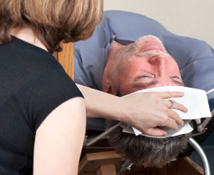Traction

What is traction therapy?
Traction is simply a pulling force. This pulling force affects mainly the soft tissues and discs in the spine. There are many different techniques of traction and mechanical loading of weight that can be used to target different conditions. Traction may alleviate back pain by stretching tight spinal muscles that result from spasm. It will also relieve nerve root impingement.
What are the different traction techniques?
Static traction – Static traction is used for several minutes to several hours. The purpose is to immobilize a body part and allow the soft tissues to relax. It can be done in the hospital, office or home.
Intermittent – Utilizes a mechanical traction device that alternately applies traction and allows relaxation for a time period of several minutes to a half an hour. This allows stretching of the soft tissues, joint separation and disc manipulation.
Manual - Manual traction is applied manually by the doctor. It is traditionally done by hand however belts, towels and harnesses may be used.
Flexion / distraction - Also known as Cox Flexion / distraction. This traction is achieved with the use of a specialized table. The patient is placed face down and the ankles are strapped to the end of the table. The lower half the table is flexed and a specific traction force is applied by hand to the low back. The traction force produces a vacuum or suction effect on the disc. This draws the disc protrusion or disc herniation centrally, away from the nerve.
Manual loading techniques – Also known as McKenzie technique. This method is an overall program of assessment, treatment and prevention strategies (including exercise) to correct disc problems.
What conditions respond best to therapeutic traction?
- Disc protrusion and herniation
- Joint dysfunction
- Low back pain
- Sports injuries
- Auto accident injuries
- Work injuries
- Spondylolisthesis
- Sciatica
- Pinched nerve
- Muscle spasm
- Facet syndrome
- Neck pain
- Numbness
- Spinal stenosis
